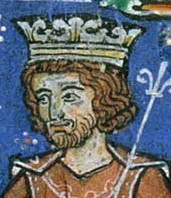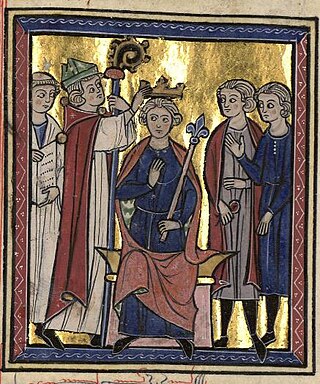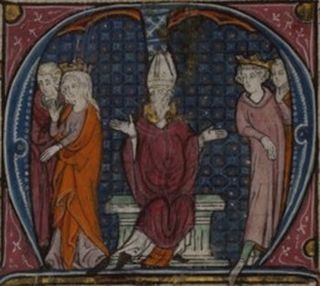
Amalric was King of Jerusalem from 1163, and Count of Jaffa and Ascalon before his accession. He was the second son of Queen Melisende and King Fulk, and succeeded his older brother King Baldwin III. During his reign, Jerusalem became more closely allied with the Byzantine Empire, and the two states launched an unsuccessful invasion of Egypt. He was the father of three future rulers of Jerusalem, Sibylla, Baldwin IV, and Isabella I.

The Kingdom of Jerusalem, also known as the Crusader Kingdom, was a Crusader state that was established in the Levant immediately after the First Crusade. It lasted for almost two hundred years, from the accession of Godfrey of Bouillon in 1099 until the fall of Acre in 1291. Its history is divided into two periods with a brief interruption in its existence, beginning with its collapse after the siege of Jerusalem in 1187 and its restoration after the Third Crusade in 1192.

Melisende was Queen of Jerusalem from 1131 to 1153, and regent for her son between 1153 and 1161, while he was on campaign. She was the eldest daughter of King Baldwin II of Jerusalem, and the Armenian princess Morphia of Melitene.

Baldwin IV (1161–1185), known as the Leper King, was the king of Jerusalem from 1174 until his death in 1185. He was admired by his contemporaries and later historians for his willpower and dedication to the Latin Kingdom in the face of his debilitating leprosy. Choosing competent advisers, Baldwin ruled a thriving crusader state and succeeded in protecting it from the Muslim ruler Saladin.

Fulk, also known as Fulk the Younger, was King of Jerusalem with his wife, Queen Melisende, from 1131 until his death in 1143. Previously, he was Count of Anjou, as Fulk V, from 1109 to 1129. During Fulk's reign, the Kingdom of Jerusalem reached its largest territorial extent.

The Crusader states, or Outremer, were four Catholic polities that existed in the Levant from 1098 to 1291. Following the principles of feudalism, the foundation for these polities was laid by the First Crusade by the European Christians, which was proclaimed by the Latin Church in 1095 in order to reclaim the Holy Land after it was lost to the 7th-century Arab Muslim conquest. Situated on the Eastern Mediterranean, the four states were, in order from north to south: the County of Edessa (1098–1150), the Principality of Antioch (1098–1268), the County of Tripoli (1102–1289), and the Kingdom of Jerusalem (1099–1291).

Sibylla was the queen of Jerusalem from 1186 to 1190. She reigned alongside her husband Guy of Lusignan, to whom she was unwaveringly attached despite his unpopularity among the barons of the Kingdom of Jerusalem.

Agnes of Courtenay was a Frankish noblewoman who held considerable influence in the Kingdom of Jerusalem during the reign of her son, King Baldwin IV. Though she was never queen, she has been described as the most powerful woman in the kingdom's history after Queen Melisende.

The king or queen of Jerusalem was the supreme ruler of the Kingdom of Jerusalem, a Crusader state founded in Jerusalem by the Latin Catholic leaders of the First Crusade, when the city was conquered in 1099. Most of them were men, but there were also five queens regnant of Jerusalem, either reigning alone suo jure, or as co-rulers of husbands who reigned as kings of Jerusalem jure uxoris.
Morphia of Melitene was the queen consort of the crusader Kingdom of Jerusalem from 1118 until her death. She was an Armenian by ethnicity and an adherent of the Greek Orthodox faith. Her father, Gabriel, was a warlord in northern Syria. He wished to marry her off to one of the crusade leaders who were carving out states in the Levant, and eventually chose Count Baldwin II of Edessa. They married around 1100 and had four daughters: Melisende, Alice, Hodierna, and Ioveta. In 1118, Baldwin was elected king of Jerusalem; the next year, Morphia became the first woman to be crowned queen of Jerusalem. She did not participate in the government but took initiative to liberate her husband after he was captured in 1123. She died a few years later. According to historian Bernard Hamilton, her religious practices left a lasting mark on the status of Orthodox Christians in the crusader kingdom.
Alice of Jerusalem was a Princess consort of Antioch by marriage to Bohemond II of Antioch. She engaged in a longlasting power struggle during the reign of her daughter Constance of Antioch.
Ioveta was a Latin princess from the crusader Kingdom of Jerusalem. Her name appears in various other forms, including Joveta, Yveta, Yvette, Ivetta, and Juditta. She headed the Convent of Saint Lazarus in Bethany, the richest abbey in the kingdom, from the late 1130s or early 1140s until her death.
Sibylla of Anjou was a countess consort of Flanders as the wife of Count Thierry. She ruled the County of Flanders as regent during the absence of her spouse from 1147 to 1149.

Bethany, locally called in Arabic Al-Eizariya or al-Aizariya, is a Palestinian town in the Jerusalem Governorate of Palestine, bordering East Jerusalem, in the West Bank. The name al-Eizariya refers to the New Testament figure Lazarus of Bethany, who according to the Gospel of John, was raised from the dead by Jesus in the town. The traditional site of the miracle, the Tomb of Lazarus, in the city is a place of pilgrimage.

The Tomb of Lazarus is a traditional Christian pilgrimage in the al-Eizariya suburb of Jerusalem Governorate, Palestine. It is located on the southeast slope of the Mount of Olives, some 2.4 km east of the city limits of Jerusalem. The tomb is the purported site of a miracle recorded in the Gospel of John in which Jesus raised Lazarus from the dead.
William of Malines was a Flemish priest who was the Prior of the Church of the Holy Sepulchre from 1127 to 1130 and was then Latin Patriarch of Jerusalem from 1130 until his death. He is sometimes called William I to distinguish him from William of Agen, second patriarch of that name, but he was the second William to serve as prior of the Holy Sepulchre after William the Englishman.

Amalric of Nesle was a Catholic prelate who served as the Latin patriarch of Jerusalem from late 1157 or early 1158 until his death. Amalric focused chiefly on managing church property; he showed very little political initiative and had no interest in military affairs.

The timeline of the Kingdom of Jerusalem presents important events in the history of the Kingdom of Jerusalem—a Crusader state in modern day Israel and Jordan—in chronological order. The kingdom was established after the First Crusade in 1099. Its first ruler Godfrey of Bouillon did not take the title of king and swore fealty to the Latin Patriarch of Jerusalem, Daimbert. Godfrey's brother and successor Baldwin I was crowned the first king of Jerusalem without doing homage to the patriarch in 1100. By 1153, Baldwin I and his successors captured all towns on the Palestinian coast with the support of Pisan, Genoese and Venetian fleets and also took control of the caravan routes between Egypt and Syria. The kings regularly administered other crusader states—the Counties of Edessa and Tripoli and the Principality of Antioch—on behalf of their absent or underage rulers.
Roger was the second bishop of Lydda and Ramla from at least 1112 until 1147.
Stephanie of Courtenay was a Latin noblewoman from the crusader states who served as the abbess of Great Saint Mary's in Jerusalem. She belonged to the House of Courtenay which ruled the County of Edessa and worked to further her abbey's wealth and standing. She is best known as a source of information for William of Tyre's chronicle of the crusader states.

![Reproduction (by Sebastiano Paoli [it]) of the seal of Abbess Ioveta, who is depicted on the obverse veiled and holding a book with a cross; on the reverse, the resurrection of Lazarus Seal of Abbess Ioveta.jpg](http://upload.wikimedia.org/wikipedia/commons/thumb/9/92/Seal_of_Abbess_Ioveta.jpg/220px-Seal_of_Abbess_Ioveta.jpg)













